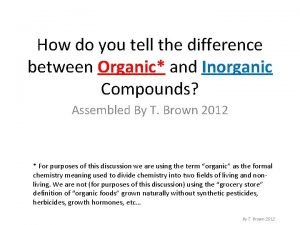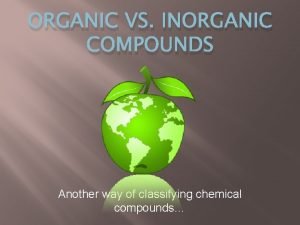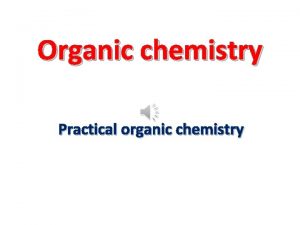Inorganic Chemistry Organic Reagents use in Inorganic Analysis












- Slides: 12

Inorganic Chemistry Organic Reagents use in Inorganic Analysis

Organic Reagents Reagent is generally known as the substance used in a chemical reaction to detect, measure, examine or produce other substances. Because of the reactions it causes. They are mainly used in analysis and synthesis Organic reagents are used for detection or estimation of inorganic or organic substances by micro or macro analysis are called organic reagents

History • In the 17 th century Boyle, who has been considered to the father of scientific method in analytical chemistry, used various organic reagents in inorganic analysis. They were mostly vegetable extracts; e. g. litmus was used as an acid-base indicator. • The first ever reported organic reagent was α-nitroso-β-naphthol which was used as a reagent for the identification of cobalt

Characteristics of Organic Reagents • The requirements for the organic reagent are dictated by the analytical method used • Should complex Forming agents (Form complexes with metals ion to be determined/identified. • Should form colored solutions or precipitates with metal ions • Should have Large Surface area • Should stable complexes with metal ions • Should have high molecular weight to give large amount of precipitates

Cont…. • Must be highly specific for desired metal analysis • Should be highly selective • Should be Sensitive specificity : Method's ability responding to one single analyte only, selectivity is used when the method is able to respond to several different analytes in the sample.

Classification of Organic Reagents Salt Forming Adsorption Acidic Basic Normal Complex Acidic Aliphatic Basic Aromatic Aliphatic Aromatic

1 Adsorption Organic Reagent • They have high tendency to adsorb on soluble complex or precipitates • React with metal ions Non Stoichiometrically Conditions • Should give sufficient amount of precipitates • Precipitates should be in colloidal form • Should have opposite charge as of metal ion or anions • Should give Sharp change in color Colloidal precipitates consist of particles that have a diameter less than which cannot be seen by naked eyes They have Acidic Functional groups as binding sites like –OH , -COOH etc

Acidic Organic Reagent Have acidic functional groups as binding sites like –OH, COOH etc Fluorescein (Physical Adsorption) Fluorescein & Eosin Use in Silver Nitrate Titration Determine : Chloride & Bromide ion Eosin

EBT (Eriochrom black-T or Solochrome Black-T) • Determine : Different Metal ions like Calcium, Magnesium Ions • Used in EDTA Titration • Chemical Adsorption

Basic Organic Reagents • They contain basic functional groups as binding sites like -NH Anthraquinone Used in Cr 3+ & Al 3+ Analysis Rhodanine Used in Iodide Analysis

Salt Forming Complex Salt forming Organic Reagent • They have acidic or basic functional groups like –COOH, -NO 2 , -OH having coordination sites for making complex ring structures with metal ions. Gravimetric Analysis Volumetric Analysis Spectrophotometric Analysis Gravimetric analysis is a technique through which the amount of an analyte (the ion being analyzed) can be determined through the measurement of mass. Volumetric analysis, any method of quantitative chemical analysis in which the amount of a substance is determined by measuring the volume that it occupies. Spectrophotometry is a tool for quantitative analysis of molecules depending on how much light is absorbed by colored compounds.

DMG (Dimethyl Glyoxime) Bidentate Ligand Used for • Gravimetric Analysis of Pb 2+& Ni 2+ • Spectrophotometric determination of Fe 2+ Co 2+and Ni 4+ • Volumetric determination of Ni 4+ EDTA (Ethylene Diamine Tetra Acetic Acid ) • Hexadentate Ligand • Highly Selective Organic reagent • Useful in spectrophotometric & volumetric analysis • Partial soluble in water and completely soluble in ethanol
 Organic vs inorganic chemistry
Organic vs inorganic chemistry Organic vs inorganic
Organic vs inorganic Functional groups ib chemistry
Functional groups ib chemistry Smear layer dental definition
Smear layer dental definition Organic and inorganic compounds experiment
Organic and inorganic compounds experiment Which compound is inorganic
Which compound is inorganic Organic chemistry chapter 1
Organic chemistry chapter 1 Organic molecules vs inorganic molecules
Organic molecules vs inorganic molecules Organic and inorganic cofactors
Organic and inorganic cofactors Difference between organic and inorganic
Difference between organic and inorganic Organic and inorganic cofactors
Organic and inorganic cofactors Saturated hydrocarbon
Saturated hydrocarbon Organic vs inorganic compounds
Organic vs inorganic compounds






















